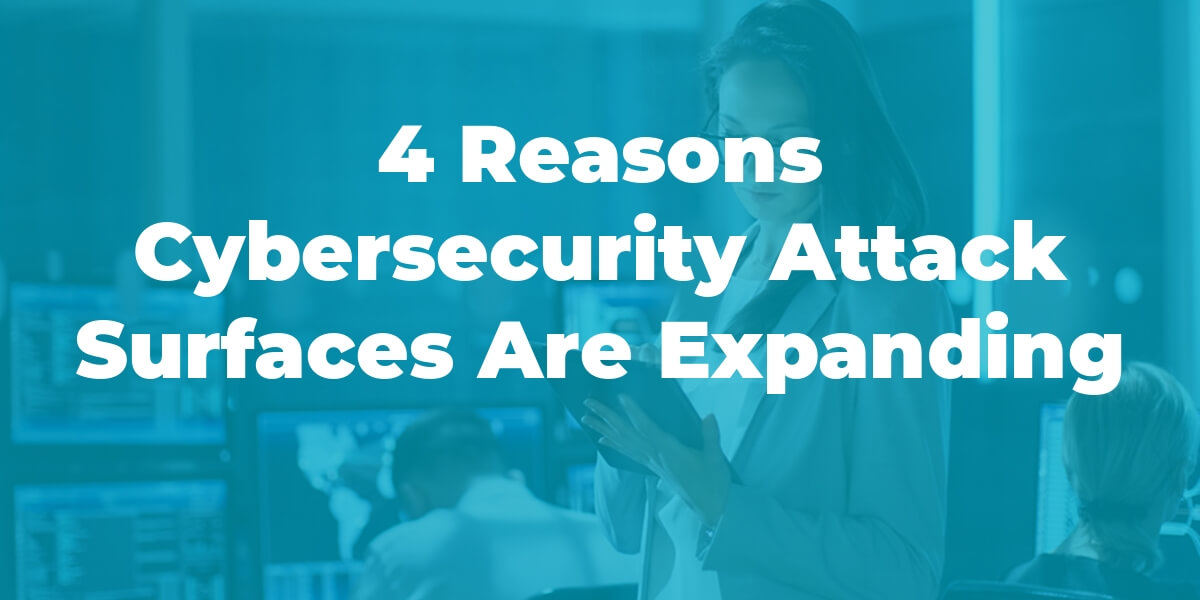The COVID-19 pandemic impacted individuals and businesses worldwide in one way or another. Almost overnight, it disrupted how people went about their daily routines and how companies operated. Amidst all the chaos, changes to the cyber landscape increased at an unprecedented pace. Some of the trends that powered these changes and continue to fuel them are:
Increased Use of the Internet of Things (IoT)
- About 56 federal agencies in the U.S. reported using Internet of Things (IoT) technologies.1
- In 2021, experts expected the number of connected devices to reach 10.07 billion.2
Rapid Adoption of the Cloud
- Global public cloud end-user expenditure is expected to grow by over 18% in 2021.3
Digital Transformation
- IT spending is expected to hit $3.9 trillion in 2021.3
- Spending on digital transformation technologies increased from $1 trillion in 2018 to $2.39 trillion in 2021.2
Work-From-Home Model
- Over 70% of all departments and teams are expected to have remote workers by 2028.4
With an expanding attack surface comes cybercrime. According to an FBI report, cyberattacks have skyrocketed by over 400% since the pandemic, making it imperative to identify and deflate cyber threats for the health and future of your business.
Growing Cybersecurity Risks
Targeted Ransomware Attack
Ransomware attacks have long been a nuisance to businesses. Experts have estimated that about 10% of breaches reported in 2021 involved ransomware.5 The success of this attack mode is attributed to the simplicity with which an attacker can wreak havoc. It should worry everyone that ransomware kits are inexpensively available on the dark web.
Ransomware propagators are constantly devising new plans to evade defenses set by businesses. Without precautionary measures in place, SMBs could find themselves at risk.
Phishing Attacks
Phishing uses social engineering in email and cloud services attacks. Phishing attacks can lead to account takeover, credential theft, and more. According to one report, phishing attacks increased by 11% in 2021 alone.5
Malicious actors using phishing scams as their method of attack are cunning enough to tilt every global event to their advantage. For example, when the pandemic started, phishing emails were sent out to the masses in the World Health Organization (WHO) name. Later, when vaccines were rolled out, scam emails had a vaccine company’s name as the sender.
Insider Threats
Shockingly, close to 20% of breaches involve internal actors.5 The problem with insider threats is that they’re often the toughest to detect.
The most common causes of inside incidents are:
- Negligent employees or contractors6 – 62%
- Criminal or malicious insiders6 – 23%
- Credential theft6 – 14%
Fileless Attacks
A fileless attack exploits the features and tools of a victim’s environment. It doesn’t depend on file-dependent payloads or generate a new file. This leaves no footprint and makes fileless attacks very hard to detect. A fileless attack is ten times more successful than a file-based attack.7
Fileless attacks can originate through an email that directs you to a malicious website. From there, using social engineering tactics, the cybercriminal can use system tools (such as PowerShell) to distribute payloads and execute commands. Since these system tools are part of your IT environment, the threat can evade outdated security systems.
How to Stay Protected
You can ramp up your IT security and protect your business by following these steps:
- Automating patch and vulnerability management keeps your systems updated and safe from cyberattacks that exploit known software vulnerabilities.
- Ensure effective and quick recovery from cyber disruption by backing up your systems and SaaS applications.
- Secure your systems by deploying advanced antivirus and antimalware solutions that provide endpoint detection and response (EDR).
- Ensure every new device has the necessary security tools— local firewall, DNS filtering, malware protection, multifactor authentication (MFA), and disk encryption.
- Always be ready with an incident response plan. No breach can shake you if you have a robust action plan. The plan should have a communication strategy with all stakeholders, including your investors and valued customers.
- Provide regular security training to your employees and vendors.
If thinking about assessing your current cybersecurity posture gives you anxiety, and you’re not sure where to start, don’t worry. We can take the assessment off your plate and suggest the right solutions for your business. An experienced partner like us can make your cybersecurity journey seamless and successful. Contact us today for your cybersecurity assessment.
Sources:
1. US GAO-20-577 Report
2. Statista
3. Gartner
4. Upwork Report
5. Verizon 2021 DBIR
6. 2020 Cost of Insider Threats: Global Report
7. Ponemon Institute
